Leave Particle Defects "in the Dust" with Automated Visual Inspection of Glass & Films
Dust is everywhere. Even the cleanest cleanroom is never 100% contaminant free as long as humans and machines are active there. A fully-gown adult will generate 100,000 particles per minute when standing still—from clothing fibers, skin, hair, and cosmetic products—and up to 1,000,000 particles per minute when walking.1 Assembly equipment can shed tiny metal or composite particles from friction between different parts. Those particles join with flecks of processing fluids and equipment lubricants, glass or plastic dust from cutting through materials, paint flakes, fibers and liquids from cleaning, etc.—and end up anywhere in the assembly line.
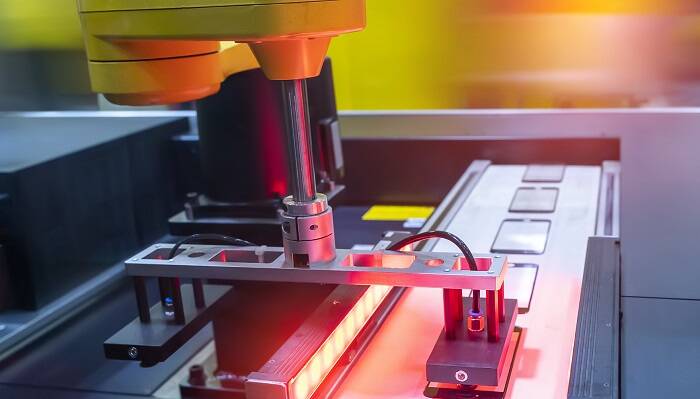
Even in a cleanroom assembly environment, machinery and humans generate particulate matter that can land on product surfaces or adhere to films and coatings.
Small particles demonstrate Brownian motion, meaning that they float for long periods of time and move unpredictably, diffusing from areas of high concentration to spread throughout a room.2 Even HEPA filters (“high efficiency particulate air” filters, capable of capturing 99.97% percent of contaminants that are 0.3 microns or larger3), can’t always keep up. This means that quality control can be challenging for high-end products that must present a “perfect” visual appearance to meet customer expectations, but that have many layers, surfaces, and coatings where particles can be caught.
Eliminating Particle Defects on Glass and Surfaces
Today’s electronic devices include multiple layers of glass, plastic, and transparent films, where particles can easily adhere or become trapped. For example, a high-end smart phone might include reflective polarizer layer, a film to enhance brightness, a diffuser layer, and specular reflector, all adhered together during production. Particle inspection (a subset of cosmetic surface inspection) detects particles and foreign materials that would be visible to a customer or harmful to a product. Transmissive material layers must be inspected prior to assembly to ensure there are no particles on, under, or embedded within them, and again after lamination to ensure no contaminants have become trapped between layers.
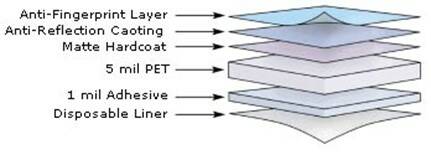
Example of the multiple protective layers that can cover one of today’s high-performance touch screens—not including the screen and illuminated display layers.
Cover glass used for phones, laptops, and other display devices is often coated to reduce glare, smudging, and other effects. If a particle is detected during inspection at any stage in the production process, it is critical to know if the particle is embedded in the material (the unit must be discarded), trapped in the coating interface (re-application of the coating may be possible), or is on the top or bottom surface (the surface can be easily wiped off).
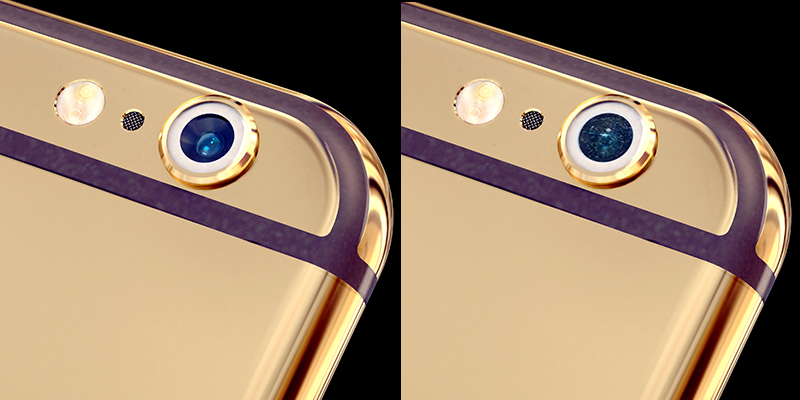
Dust below a smartphone camera lens (right) may not be easily visible to the naked eye, but it can interfere with the quality of photography and device functioning. The particles can be detected before a product ships using an inspection regimen that incorporates an automated visual imaging system such as a ProMetric camera from Radiant, plus specialized lighting to reduce glare from specular glass and increase particle contrast.
Importance of Visual Surface Inspection
Product quality expectations in consumer electronics are arguably the highest in any industry. Customers demand perfection in their devices and newly released technologies are routinely reviewed in excruciating detail. A subtle scratch on a laptop surface, or miniscule dust particles behind the glass of a smartphone camera lens, are sufficient cause for product returns. If widespread, these issues may lead to recalls, costing manufacturers excessive time and money.
To safeguard both your brand and your bottom line, it is imperative to integrate cosmetic surface inspection and particle inspection into quality control operations during production and at final assembly. Combining high-resolution imaging, lighting, and automation, Radiant’s Advanced Vision solutions are designed to perform a range of functions from particle to surface to assembly inspection, employing a library of software tools for total quality control.
The Particle Inspection Solution
Radiant’s high-resolution ProMetric® imaging systems—coupled with our TrueTest™ Software and expert detection algorithms—can spot unwanted particles on and in surfaces, glass, and transparent layers. Camera dynamic range increases the number of grayscale values in each image, ensuring that subtle contrast variations are identifiable. Low noise ensures that pixel-sized particles are clearly discernable from image noise, so they can be identified and removed before assembly or shipping. Radiant engineers tune the process by setting thresholds and key detection criteria to meet specific and demanding requirements.
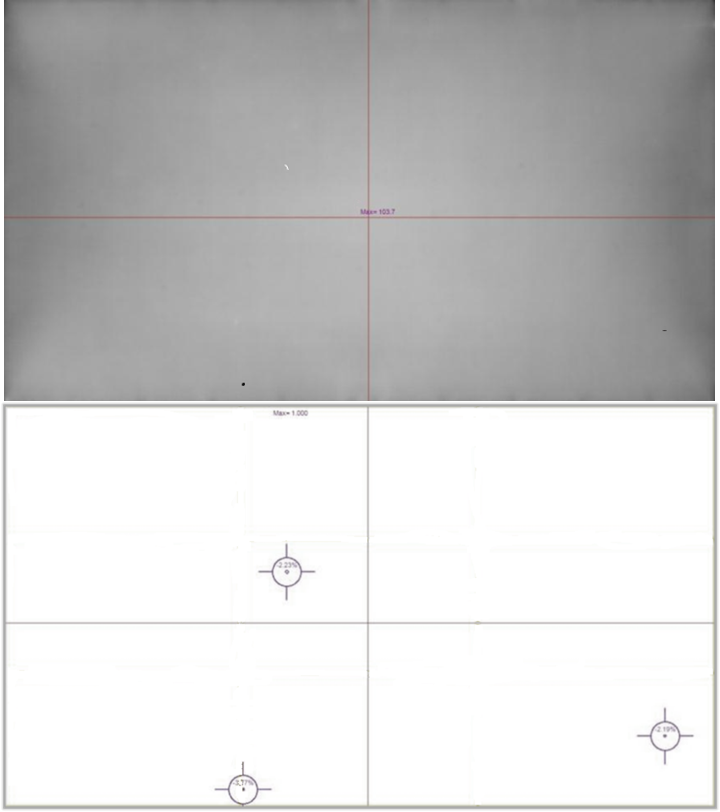
Radiant ProMetric cameras capture accurate images of a metallic surface (top) and automated visual inspection software measures and analyzes the position and severity of particle defects (bottom) to help manufacturers determine if they can be removed or the part must be scrapped.
Radiant’s systems offer the imaging sensitivity to detect defects even in low-contrast situations (such as dark particles on a dark surface or light particles on a light or metallic surface). Minute contrast variations within an imaged area allow our cameras to assess the presence and location of particles. Systems can then apply defined tolerances to determine the acceptable severity of a particle or number of particles within or on materials.
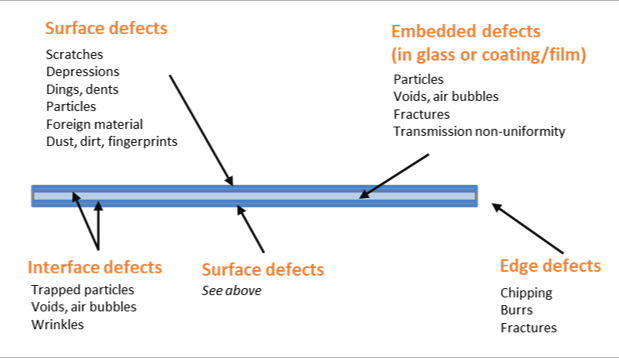
Radiant’s particle inspection solution can classify defects by type and pinpoint the exact location of particles in or on device layers. Beyond particles, our Advanced Vision solutions perform a full range of cosmetic surface inspection tasks.
Used for particle inspection, Radiant’s Advanced Vision solutions provide all the benefits of automated visual inspection, including objective analysis and quantifiable results, while capturing the data needed for error tracking to improve production operations. Any defects that may be missed by human inspectors are easily captured, classified, and reported by cameras leveraging high-resolution imaging performance developed through Radiant’s expertise in scientific photometric imaging for metrology applications.
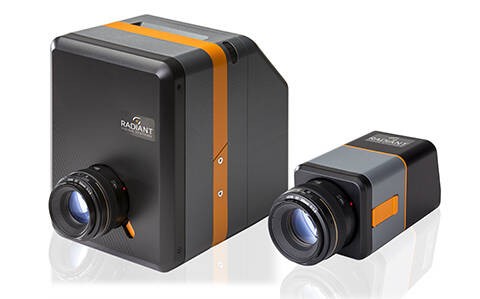
ProMetric Imaging Colorimeters (left) and Imaging Photometers (right) provide the high-resolution, low-noise imaging needed to accurately detect minute particles and help manufacturers achieve device quality.
CITATIONS
- Ramstorp, M. (Ed.), Introduction to Contamination Control and Cleanroom Technology, Wiley-VCH Verglag, Gmbh (2000). DOI:10.1002/9783527613120
- Whyte, W. Agricola, K, and Derks, M, “Airborne particle deposition in cleanrooms: Deposition mechanisms”, Clean Air and Containment Review, Issue 24, October 2015
- Indoor Air Quality: What is a HEPA Filter?, U.S. Environmental Protection Agency. (Retrieved March 10, 2021)
Join Mailing List
Stay up to date on our latest products, blog content, and events.
Join our Mailing List
